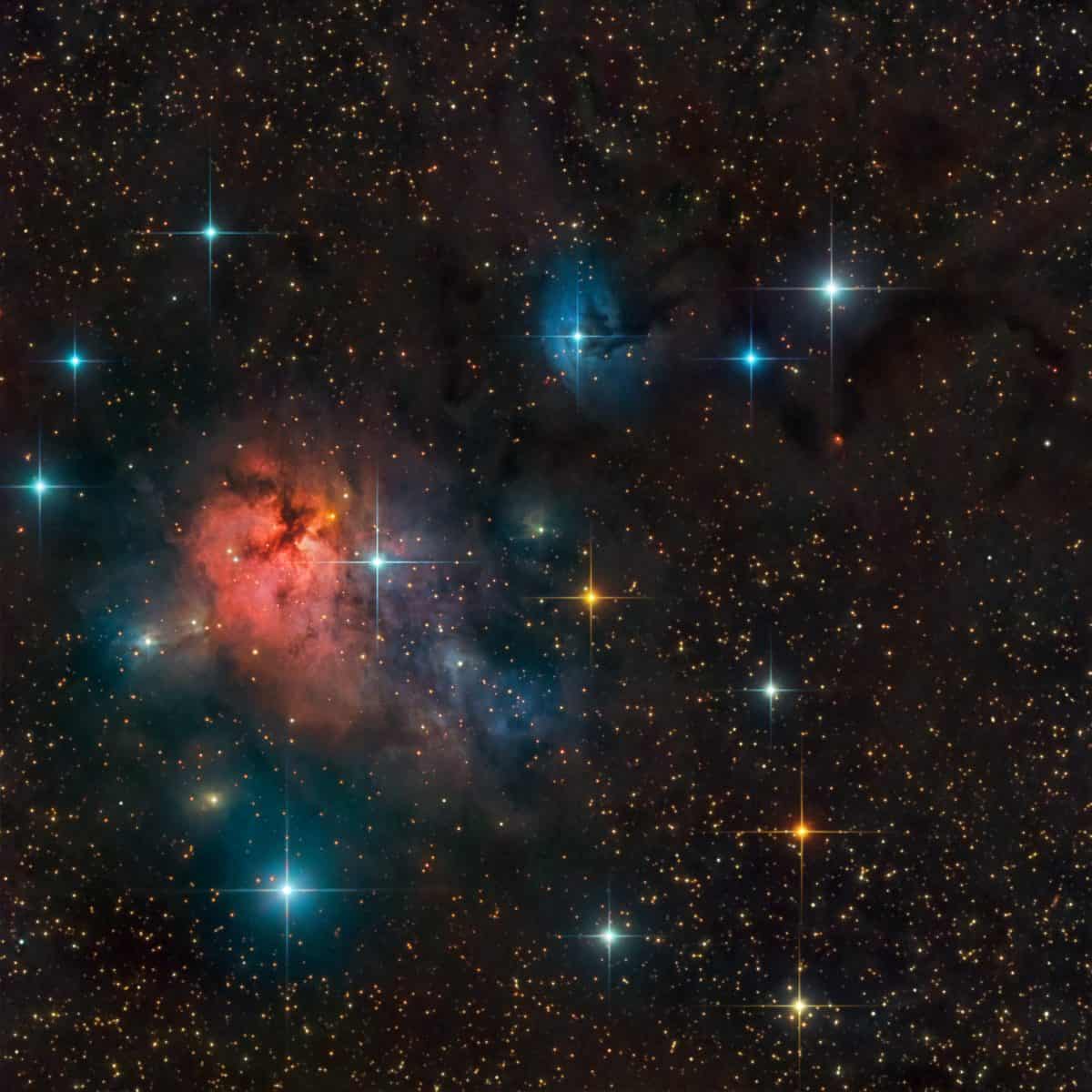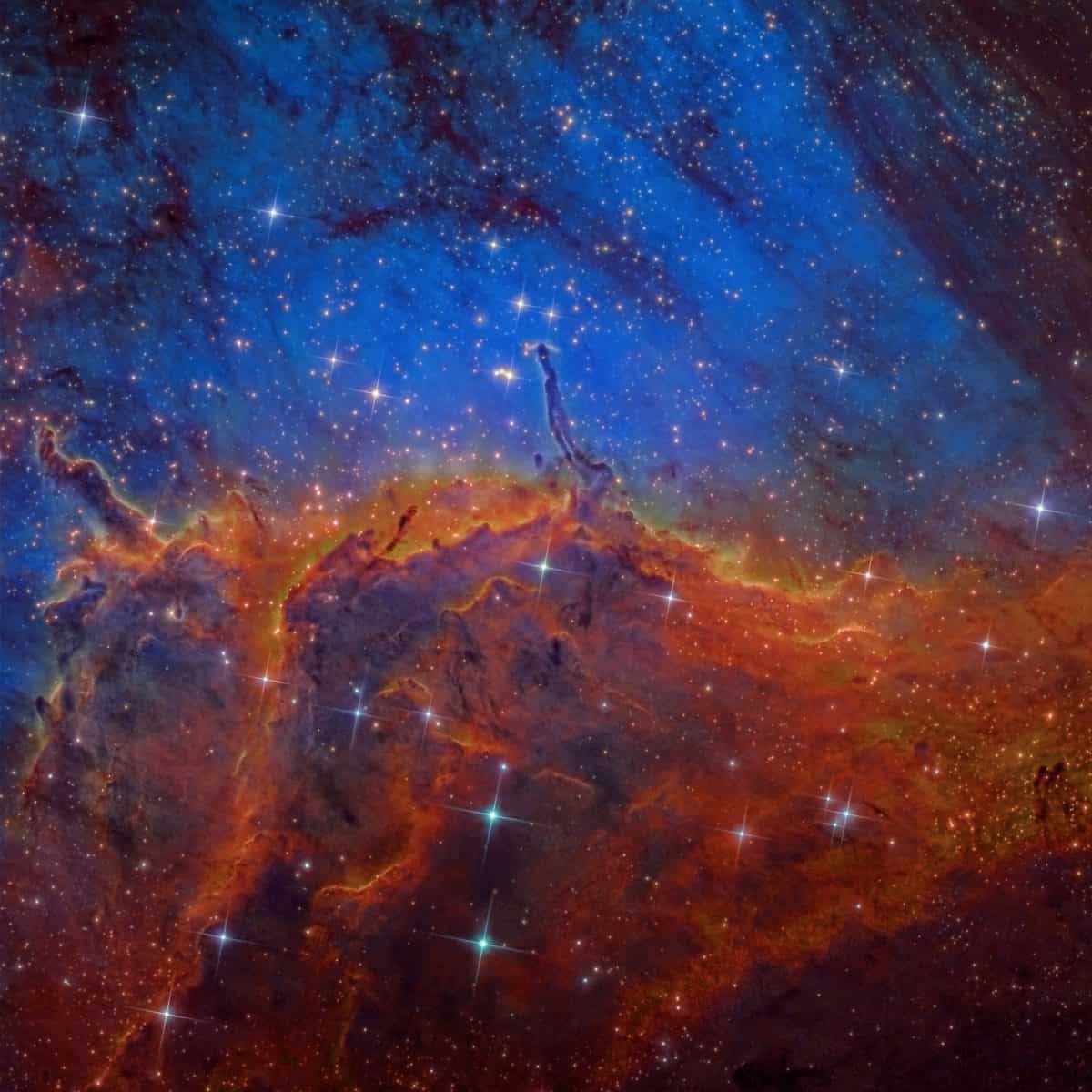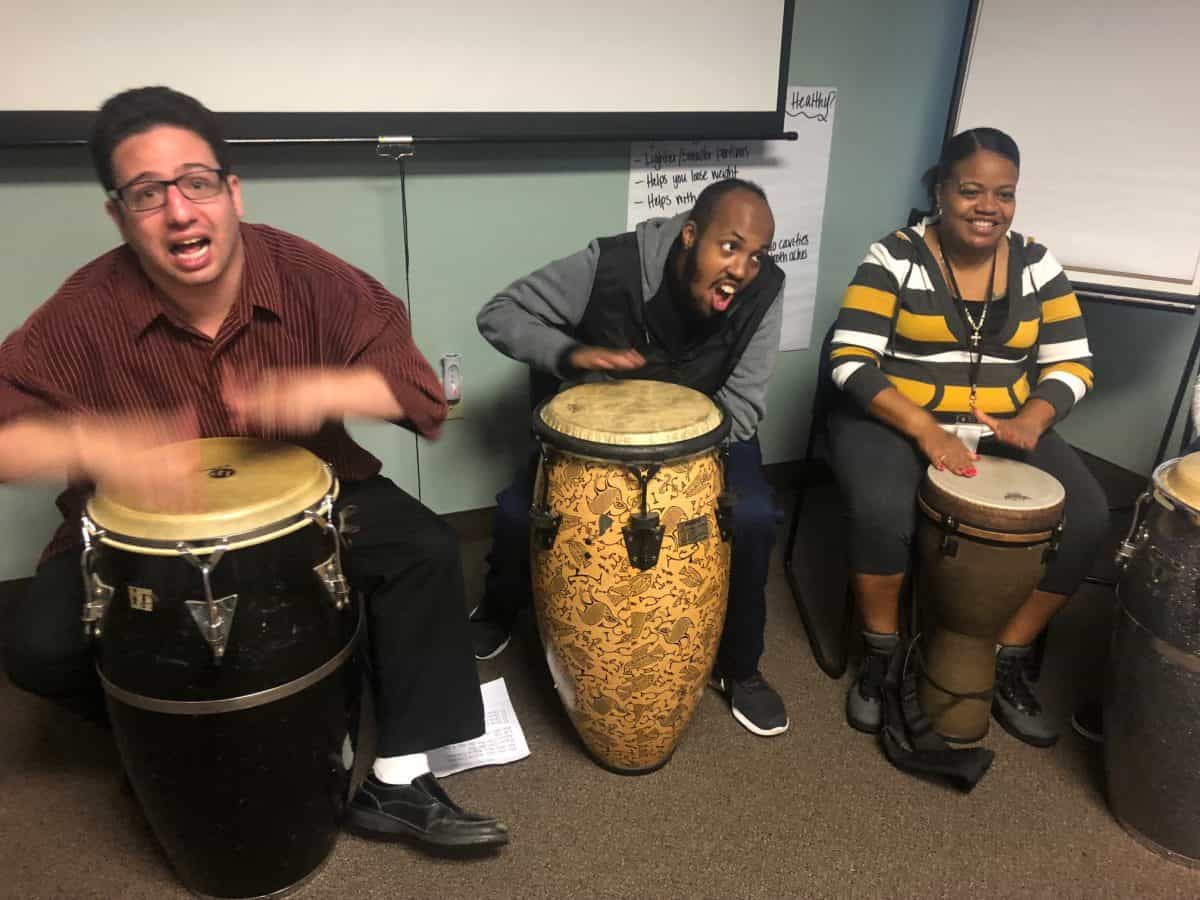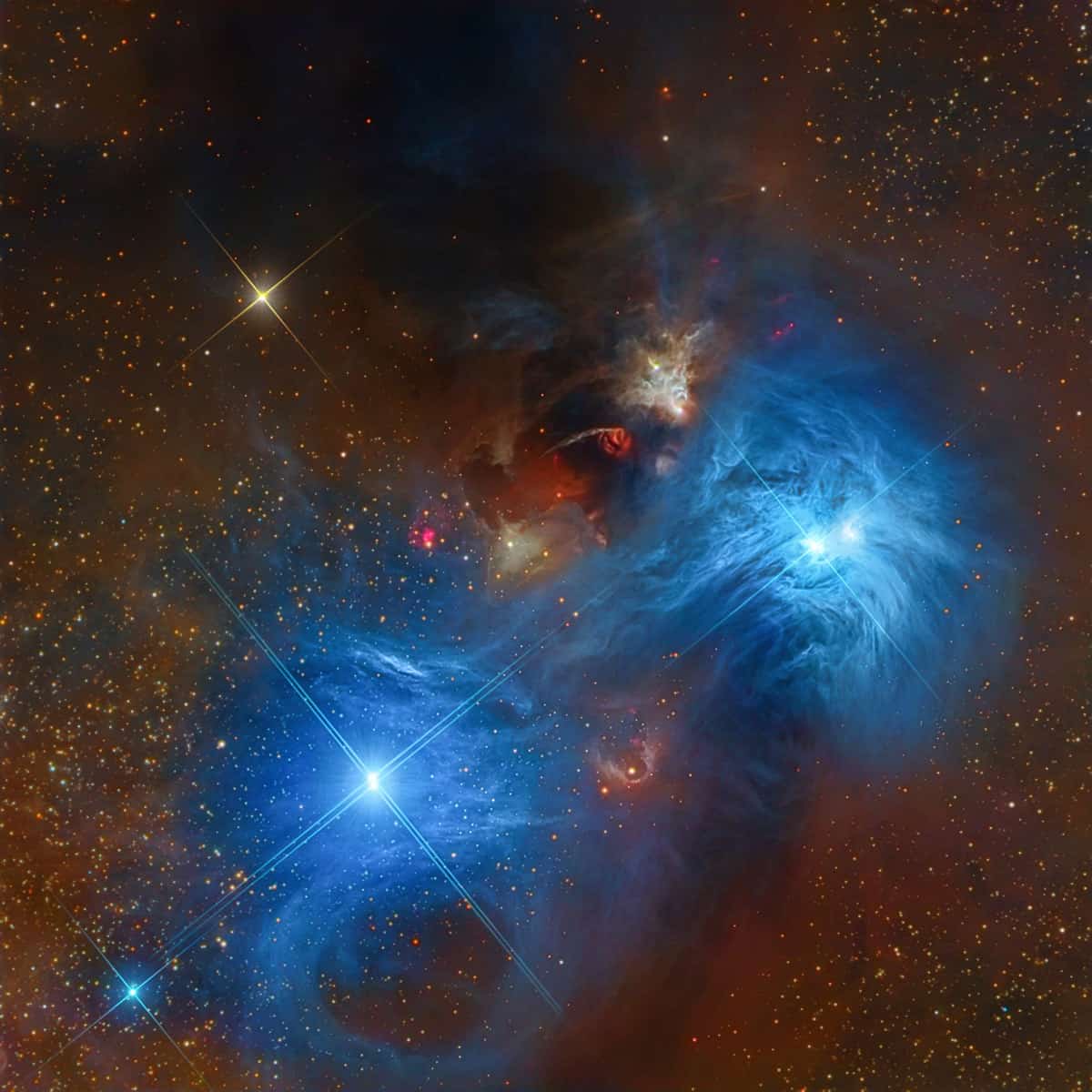Blog
The men and women of Ensemble Tartit are Tuaregs residing in the Timbuktu and the Goundam region of the Niger River basin in Northern Mali.
more...Colorful NGC 1579 resembles the better known Trifid Nebula, but lies much farther north in planet Earth’s sky, in the heroic constellation Perseus. About 2,100 light-years away and 3 light-years across, NGC 1579 is, like the Trifid, a study in contrasting blue and red colors, with dark dust lanes prominent in the nebula’s central regions. In both, dust reflects starlight to produce beautiful blue reflection nebulae. But unlike the Trifid, in NGC 1579 the reddish glow is not emission from clouds of glowing hydrogen gas excited by ultraviolet light from a nearby hot star. Instead, the dust in NGC 1579 drastically diminishes, reddens, and scatters the light from an embedded, extremely young, massive star, itself a strong emitter of the characteristic red hydrogen alpha light.
more...Ed Cherry (October 12, 1954 New Haven, CT) is an American jazz guitarist and studio musician. Cherry is perhaps best known for his long association with trumpeter Dizzy Gillespie, with whom he performed from 1978 until shortly before Gillespie’s death in 1993. Since that time, he has worked with Paquito D’Rivera, Jon Faddis, John Patton, Hamiet Bluiett, Henry Threadgill, and Paula West. He has recorded a number of albums as a leader.
https://www.youtube.com/watch?v=aUVfV_2BZhI
more...Melvin Rhyne (October 12, 1936 – March 5, 2013, Indianapolis, Indiana), was a jazz organist best known for his work with Wes Montgomery.
Melvin Rhyne was born in Indianapolis in 1936 and started playing the piano shortly after. At 19 years old, Rhyne started playing piano with then-unknown tenor saxophonist Rahsaan Roland Kirk but quickly switched over to the instrument that would make him famous: the Hammond B3 organ. Rhyne’s piano skills translated to the organ fluently and before long he was backing famous blues players like B.B. King and T-Bone Walker. In 1959 he was asked to join fellow Indianapolis musician Wes Montgomery‘s newly formed trio.
Rhyne then moved to Wisconsin and largely kept to himself for the next two decades. In 1991, however, he played on Herb Ellis‘s album Roll Call, Brian Lynch‘s At the Main Event, and his own album, The Legend. He continued to be prolific in the years to come, releasing eight more solo albums on the Criss Cross Jazz label. Rhyne also recorded with The Mark Ladley Trio for the 1992 release, Strictly Business and the 1994 release, Evidence. Both landed in the Jazz Charts at CMJ New Music Report and The Gavin Report. The group also appeared on a Jazziz Magazine sampler disc during that time. Altenburgh Records posthumously released, Final Call in 2013 by the same group.
https://www.youtube.com/watch?v=mY9eso_YyDY
more...World Music on Flamenco Fridays with Agustin Carbonell ‘Bola’ performing Tangos.
In flamenco a tango (Spanish pronunciation: [ˈtaŋɡo]) is one of the flamenco palos closely related in form and feeling to the rumba flamenca. It is often performed as a finale to a flamenco tiento. Its compás and llamada are the same as that of the farruca and share the farruca’s lively nature. However, the tango is normally performed in the A Phrygian mode. In some English sources the flamenco tango is written with an -s; “the tangos is…”
The flamenco tango is distinct from the flamenco rumba primarily through the guitar playing. In Rumba the guitar flows more freely, whereas in Tangos the accents on beats 2, 3 & 4 are marked clearly with heavy strumming.
Tangos is only vaguely related to Argentine tango, and objectively they only share compás binario or double stroke rhythm. The fact that Argentine tango is one of the first couple dances in America has led historians to believe that both could be based in a minuet-style European dance, therefore sharing a common ancestor, while those who compare the present day forms do not see them as related.
more...
World Music on Flamenco Fridays with Agustin Carbonell ‘Bola’ performing Tangos.
In flamenco a tango (Spanish pronunciation: [ˈtaŋɡo]) is one of the flamenco palos closely related in form and feeling to the rumba flamenca. It is often performed as a finale to a flamenco tiento. Its compás and llamada are the same as that of the farruca and share the farruca’s lively nature. However, the tango is normally performed in the A Phrygian mode. In some English sources the flamenco tango is written with an -s; “the tangos is…”
The flamenco tango is distinct from the flamenco rumba primarily through the guitar playing. In Rumba the guitar flows more freely, whereas in Tangos the accents on beats 2, 3 & 4 are marked clearly with heavy strumming.
Tangos is only vaguely related to Argentine tango, and objectively they only share compás binario or double stroke rhythm. The fact that Argentine tango is one of the first couple dances in America has led historians to believe that both could be based in a minuet-style European dance, therefore sharing a common ancestor, while those who compare the present day forms do not see them as related.
more...
The prominent ridge of emission featured in this vivid skyscape is designated IC 5067. Part of a larger emission nebula with a distinctive shape, popularly called The Pelican Nebula, the ridge spans about 10 light-years and follows the curve of the cosmic pelican’s head and neck. The Pelican Nebula close-up was constructed from narrowband data mapping emission from sulfur, hydrogen, and oxygen atoms to red, green, and blue colors. Fantastic, dark shapes inhabiting the view are clouds of cool gas and dust sculpted by energetic radiation from young, hot, massive stars. But stars are also forming within the dark shapes. In fact, twin jets emerging from the tip of the long, dark tendril below center are the telltale signs of an embedded protostar cataloged as Herbig-Haro 555. The Pelican Nebula itself, also known as IC 5070, is about 2,000 light-years away. To find it, look northeast of bright star Deneb in the high flying constellation Cygnus.
more...Lester Bowie (October 11, 1941 – November 8, 1999) was an American jazz trumpet player and composer. He was a member of the Association for the Advancement of Creative Musicians and co-founded the Art Ensemble of Chicago.
Born in the historic village of Bartonsville in Frederick County, Maryland, Bowie grew up in St Louis, Missouri. At the age of five he started studying the trumpet with his father, a professional musician. He played with blues musicians such as Little Milton and Albert King, and rhythm and blues stars such as Solomon Burke, Joe Tex, and Rufus Thomas. In 1965, he became Fontella Bass‘s musical director and husband. He was a co-founder of Black Artists Group (BAG) in St Louis.
In 1966, he moved to Chicago, where he worked as a studio musician, and met Muhal Richard Abrams and Roscoe Mitchell and became a member of the AACM. In 1968, he founded the Art Ensemble of Chicago[1] with Mitchell, Joseph Jarman, and Malachi Favors. He remained a member of this group for the rest of his life, and was also a member of Jack DeJohnette‘s New Directions quartet. He lived and worked in Jamaica and Africa, and played and recorded with Fela Kuti. Bowie’s onstage appearance, in a white lab coat, with his goatee waxed into two points, was an important part of the Art Ensemble’s stage show.
more...Billy Higgins (October 11, 1936 – May 3, 2001) was an American jazz drummer. He played mainly free jazz and hard bop.
In his career, he played on over 700 recordings, including recordings of rock and funk. He appeared as a jazz drummer in the 2001 movie Southlander.
more...Arthur “Art” Blakey (October 11, 1919 – October 16, 1990) was an American jazz drummer and bandleader. He was known as Abdullah Ibn Buhaina after he became a Muslim.
Blakey made a name for himself in the 1940s in the big bands of Fletcher Henderson and Billy Eckstine. He worked with bebop musicians Thelonious Monk, Charlie Parker and Dizzy Gillespie. In the mid-1950s Horace Silver and Blakey formed the Jazz Messengers, a group that the drummer was associated with for the next 35 years. The group was formed as a collective of contemporaries, but over the years the band became known as an incubator for young talent, including Freddie Hubbard, Wayne Shorter, Lee Morgan, Benny Golson, and Wynton Marsalis. The Biographical Encyclopedia of Jazz calls the Jazz Messengers “the archetypal hard bop group of the late 50s”.
He was inducted into the Down Beat Jazz Hall of Fame (in 1981), the Grammy Hall of Fame (in 1998 and 2001), and was awarded the Grammy Lifetime Achievement Award in 2005. He was inducted into the Modern Drummer Hall of Fame in 1991.
Blakey was born on October 11, 1919, in Pittsburgh, Pennsylvania, probably to a single mother who died shortly after his birth, and her name is often cited as Marie Roddicker (or Roddericker) although Blakey’s own 1937 marriage license shows her maiden name to have been Jackson. His biological father was Bertram Thomas Blakey, originally of Ozark, Alabama, whose family migrated northward to Pittsburgh sometime between 1900 and 1910. Blakey’s uncle, Rubi Blakey, was a popular Pittsburgh singer, choral leader, and teacher who attended Fisk University
more...Bambara region of Mali
more...Rhythm Roots Workshop returns to PRI Partnership Resources Inc in Minneapolis. 1130am-130pm
The last Drumming rehearsal session for MIA Minneapolis Institute of Art “Expressing Me” showcase on October 19th.
Drumming for the Developmentally Disabled community.
With Geordy, Mohammed and Yvette.
more...NGC 6726 in Corona Australis
This beautiful star forming region in the constellation Corona Australis has so much to offer, with many outstanding nebula and unusual objects. One of the more dynamic and colorful areas in the southern sky. There is an annotated image for reference.
It features NGC 2726-27 a blue reflection nebula which are clouds of interstellar dust lit up by the bright nearby stars and IC 4812 is another.
NGC 6729 is the diamond shaped object which is an Emission/Reflection nebula object that is also a variable nebula.
Bernes 157 and SL 41 are areas called Dark Nebula interstellar clouds that are dense enough to obscure the light from behind.
Herbig-Haro or HH objects are small patches of nebulosity linked to new born stars. Stars that are or have ejected gas and that gas collides with nearby clouds of gas at enormous speeds. There are many of these objects in this image.
Telescope: 16″ RCOS, FLI 16803, Planewave 200HR CTIO Chile.
21 Hours Luminance, 14.5 Red, 13.5 Green, 13.5 Blue
62 Hours Total
more...Julian Clifford Mance, Jr. (known as Junior Mance, born October 10, 1928) is an American jazz pianist and composer.
Mance was born in Evanston, Illinois. When he was five years old, Mance started playing piano on an upright in his family’s home in Evanston. His father, Julian, taught Mance to play stride piano and boogie-woogie.
Charlie Parker encouraged Mance to move to New York, which he did after saving money from working nearly a year at the Bee Hive. In 1954, Mance was asked to record with Dinah Washingtonafter Wynton Kelly was drafted. Mance toured with Washington over the next two years and learned accompaniment technique from Washington’s arranger, Jimmy Jones. EmArcy released two LPs, Dinah Jams and Jam Session, from a live session recorded August 14–15, 1954 in Los Angeles with Mance, Washington, Clifford Brown, Clark Terry, Maynard Ferguson, Herb Geller, Harold Land, Richie Powell, Keter Betts, George Morrow, and Max Roach.
https://www.youtube.com/watch?v=6zEK76RHR4g
more...Edward Joseph Blackwell (October 10, 1929 – October 7, 1992) was an American jazz drummer born in New Orleans, Louisiana, known for his extensive, influential work with Ornette Coleman.
Blackwell’s early career began in New Orleans in the 1950s. He played in a bebop quintet that included pianist Ellis Marsalis and clarinetist Alvin Batiste. There was also a brief stint touring with Ray Charles. The second line parade music of New Orleans greatly influenced Blackwell’s drumming style and could be heard in his playing throughout his career.
Blackwell first came to national attention as the drummer with Ornette Coleman‘s quartet around 1960, when he took over for Billy Higgins in the quartet’s stand at the Five Spot in New York City. He is known as one of the great innovators of the free jazz of the 1960s, fusing New Orleans and African rhythms with bebop. In the 1970s and 1980s Blackwell toured and recorded extensively with fellow Ornette Quartet veterans Don Cherry, Charlie Haden, and Dewey Redman in the quartet Old and New Dreams.
https://www.youtube.com/watch?v=j7uJc5g12Q0
more...Thelonious Sphere Monk (/θəˈloʊniəs/, October 10, 1917 – February 17, 1982 Rocky Mt, NC) was an American jazz pianist and composer. He had a unique improvisational style and made numerous contributions to the standard jazz repertoire, including “‘Round Midnight“, “Blue Monk“, “Straight, No Chaser“, “Ruby, My Dear“, “In Walked Bud“, and “Well, You Needn’t“. Monk is the second-most-recorded jazz composer after Duke Ellington, which is particularly remarkable as Ellington composed more than a thousand pieces, whereas Monk wrote about 70.
Monk’s compositions and improvisations feature dissonances and angular melodic twists and are consistent with his unorthodox approach to the piano, which combined a highly percussive attack with abrupt, dramatic use of switched key releases, silences, and hesitations. His style was not universally appreciated; the poet and jazz critic Philip Larkin dismissed him as ‘the elephant on the keyboard’.
Monk was renowned for a distinct look which included suits, hats, and sunglasses. He was also noted for an idiosyncratic habit during performances: while other musicians continued playing, Monk stopped, stood up and danced for a few moments before returning to the piano.
Monk is one of five jazz musicians to have been featured on the cover of Time magazine. The others are Louis Armstrong, Dave Brubeck, Duke Ellington and Wynton Marsalis.
In his early teens, Monk toured with an evangelist, playing the church organ, and in his late teens he began to find work playing jazz. In the early to mid-1940s, he was the house pianist at Minton’s Playhouse, a Manhattan nightclub. Much of Monk’s style (in the Harlem stride tradition) was developed during his time at Minton’s, when he participated in after-hours cutting contests, which featured many leading jazz soloists of the time. Monk’s musical work at Minton’s was crucial in the formulation of bebop, which would be furthered along by other artists, including Dizzy Gillespie, Charlie Christian, Kenny Clarke, Charlie Parker, and, later, Miles Davis.[ Monk is believed to be the pianist featured on recordings Jerry Newman made around 1941 at the club. Monk’s style at this time was later described as “hard-swinging,” with the addition of runs in the style of Art Tatum. Monk’s stated influences included Duke Ellington, James P. Johnson, and other early stride pianists. In the documentary Thelonious Monk: Straight, No Chaser, it is stated that Monk lived in the same neighborhood in New York City as Johnson and knew him as a teenager.
more...https://www.youtube.com/watch?v=Pero2scoMXc&t=0s&index=13&list=PLEB3LPVcGcWbHKyo-uy8CkVvebHEsluVK
more...More Posts
- The Cosmos with MACSJ0138.0-2155
- Jerry Garcia
- Paddy Moloney
- Ramblin’ Jack Elliott
- Elmer Crumbley
- World Music with Suhail Khoury
- Daily Roots with Joya Landis
- The Cosmos with Neowise
- Stanley Jordan
- Kenny Burrell
- Hank Jones
- World Music with Dag Tenere
- Daily Roots with Toots and the Maytals
- King Ras John at Harbor Bar
- The Cosmos with IC 2944
- David Sanborn
- Buddy Guy
- Vernel Fournier
- Flamenco Fridays with Sabicas
- Daily Roots with Jo Mersa Marley



